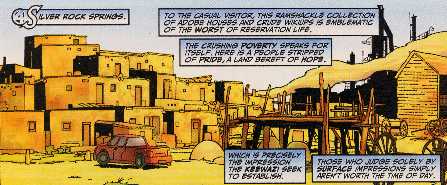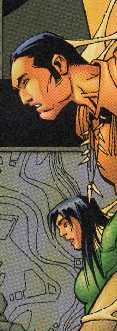 An expanded version of my Indian Comics Irregular essay Wingfooting It with Wyatt:
An expanded version of my Indian Comics Irregular essay Wingfooting It with Wyatt: An expanded version of my Indian Comics Irregular essay Wingfooting It with Wyatt:
An expanded version of my Indian Comics Irregular essay Wingfooting It with Wyatt:
Someone recently asked me what I thought of Wyatt Wingfoot. Since Wyatt is the first Native American character of the Silver Age, perhaps the first in any superhero comic, and arguably the most prominent Native character after Tonto and Turok, he deserves a review.
Wyatt is a member of the Keewazi, a fictional tribe located somewhere in the American West. The Keewazi are masters of technology behind their poor-reservation facade. Superficially, this seems unremarkable—a standard comic book gimmick.
Let's acknowledge that Wyatt himself is a positive role model. He's big, strong, and handsome—and, more important, articulate and college-educated with advanced technical expertise. His Keewazi culture also seems positive—investing its money in education, using it to build a veritable Silicon Valley of high-tech industries.
But I've written before about the problems inherent in depicting fictional countries and tribes. Wyatt's recent appearance in FANTASTIC FOUR #29 demonstrates these problems. Like one of those children's games, let's see how many things we can find wrong with this picture:
So the Keewazi are a mishmash of Apache, Pueblo, and other Southwestern Indian cultures. ("Keewazi" = Kiowa + Anasazi?) What's wrong with this fictional portrayal, if anything? It's just a comic book, right? In the Marvel Universe, perhaps the Keewazi do exist and are a mishmash of cultures, and Indians haven't become astronauts.
So what's wrong?
 What's wrong is the message this portrayal sends in the year 2000. To wit:
What's wrong is the message this portrayal sends in the year 2000. To wit:
1) The Keewazi's amalgamation of other cultures doesn't give Wyatt real cultural roots. His lack of specific cultural traits makes him shallow and superficial compared to real Indians. It ensures he remains secondary to the more deeply characterized Anglo-Americans.
2) Even though the Keewazi concept nominally paints Indians in a positive light (just as Wakanda does with Africans), this portrayal is driven by subtle condemnations. "Indians (except the Keewazi) are mired in poverty." "Indians (except the Keewazi) have no technical abilities." "Indians are too backward to send someone into space."
In other words, "No real Indian (or African, or...) is smart, brave, or noble enough to be a hero." Marvel had to invent a race of ultra-advanced people to find someone it considered worthy of associating with the Fantastic Four.
3) The Keewazi hide their wealth and knowledge behind a facade of poverty. Why? Because they're afraid of being exploited by the big, bad white folks?
Native people have faced enormous exploitation in the past, but they aren't backing off these days. Instead, they're taking the offense: with government-to-government negotiations, legal maneuvers and lawsuits, lobbying and political campaigns, economic investment and development, education and Internet access, and other modern techniques. They're recapturing their heritage, asserting their rights (especially those "guaranteed" by treaties), and proclaiming that they're here to stay. The Keewazi notion of hiding in fear is woefully incompatible with that.
Stan Lee's vision of Wyatt Wingfoot and the Keewazi was farsighted in the '60s. It's still noteworthy compared to hollow "apples" like Thunderbird, Red Wolf, and Forge (red on the surface, white at the core). But Lee's vision was and is essentially stereotypical. It doesn't portray Indian people, with all their complexities, as they really are.
On a brighter note, Wyatt also appeared in the recent EARTH X series. In the first issue he fought alongside Captain America wearing an authentic-looking version of Black Crow's outfit. (Black Crow is one of the more original Indian characters in the Marvel Universe.) If the message was that Cap and Wyatt together formed the heart and soul of America, it's a message we can endorse.
Related links
Thunderbird in the comics
Some thoughts on minority comics
Uncivilized Indians
Stereotype of the Month contest
Readers respond
"Is it always bad to use a fictional tribe?"
"It's naïve to expect a Silver Age hero to live up to 21st century sensibilities."
"These aren't real people getting killed. They're ink on a page."
"Don't encourage them to muck up smaller tribes too."
"So to portray an Amerind realistically, you must have no Amerind stereotypes whatsoever?"
|
. . . |

|
All material © copyright its original owners, except where noted.
Original text and pictures © copyright 2007 by Robert Schmidt.
Copyrighted material is posted under the Fair Use provision of the Copyright Act,
which allows copying for nonprofit educational uses including criticism and commentary.
Comments sent to the publisher become the property of Blue Corn Comics
and may be used in other postings without permission.